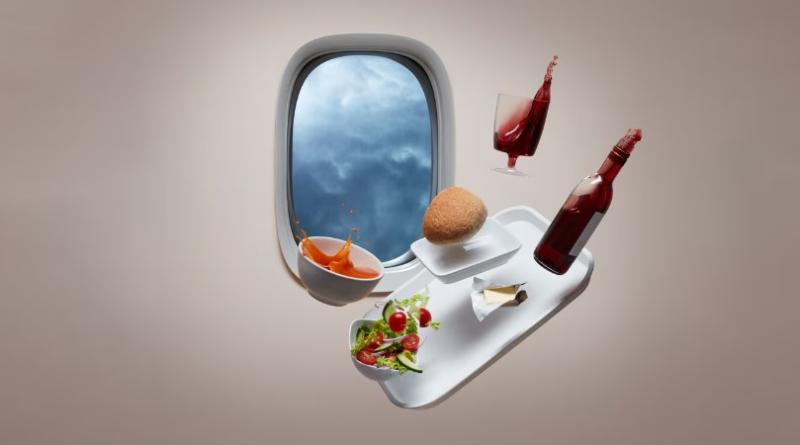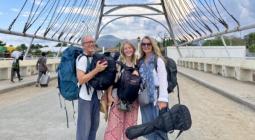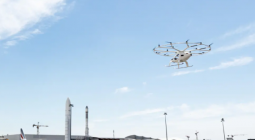‘So these are the people I’ll die with’: one nervous flyer on the terrifying rise in turbulence

Friday 24 February 2023, an afternoon flight. I’m travelling from Charleston, South Carolina, to New York’s LaGuardia airport after a vacation with my kids and a friend. In the last few years, I’ve become sufficiently weird about flying to check in advance for high wind, and today, unfortunately, it’s windy. After takeoff, the captain informs us that once we get below 10,000ft, he’ll be advising the stewards to stay seated. He uses the words a “few bumps”, which I tell myself sounds almost charming – Whoops-a-daisy! Just a few bumps! – and “moderate turbulence”, which is less reassuring. In airline parlance, “moderate”, I’m aware, means extremely unfun if you happen to be frightened of flying.
About 45 minutes before we’re scheduled to land, an attendant comes over the address system. “In light of the severe turbulence we’re expecting,” he says, “we need everyone to make sure their seatbelts are securely fastened and bags are fully underneath the seats in front. If you need to use the bathroom, go now.” There is a short pause. “This is going to be rough, folks.” I twist in my seat to look back at my friend. Jesus Christ, it’s actually happening. We’re all going to die.
For those of you who aren’t afraid of flying, let me walk you through what happens next: panic, sweat, shortness of breath. A thudding in the chest and the ears. It feels as if some essential part of me that is usually appropriately anchored lets slip its moorings and starts sliding around my insides like mercury. I scan the flight attendants for signs of unease. I glance at my children, who are playing Battleship on the seat-back screen and tell them to put on their sweatshirts (to protect them from fire after we crash). Briefly, I consider the sex toys in the drawer of my office at home that someone – God, who? – will have to dispose of after my death, and am fleetingly distracted by the observation that fear of embarrassment is more powerful than fear of death.
I look at the people around me: a young woman in a grey hoodie hunched over her phone; a guy watching CNBC. Across the aisle, a smartly dressed woman is inputting data into her laptop in defiance of the return‑your-tray-tables-to-upright advisory, so that when it flies up and imbeds itself in her skull, she’ll be killed by her own spreadsheet.
So, I think, these are the people I’ll die with.
Finally, my mind snags on the thought I have every single time this happens to me on a flight, which, at the moment, seems to be every time I fly: I just can’t believe it. I can’t believe that after all this life, all this effort, all this striving to make things work and get my taxes in on time, and find the right school, and come up with ideas and execute them, and read 10,000-word pieces about the implications of market saturation on TV streaming services, and save for college, and save for retirement, and build a life and sustain it, that this – Whoa, first big bump, there are a couple of yelps and one plucky, “Woo!” – is how it’s going to end: with the bad Game of Thrones reboot in my peripheral vision as we make our initial descent over Delaware.
Turbulence is getting worse. This is both the official story and one supported by anecdote. In March, a Lufthansa flight en route from Texas to Germany diverted to Dulles airport in Washington DC after turbulence injured seven people. Last December, a Hawaiian Airlines flight from Phoenix to Honolulu encountered turbulence so bad that 20 people required hospitalisation. In July, another Hawaiian Airlines flight, from Honolulu to Sydney, hit turbulence that injured seven people. In August, 11 people were hospitalised when a Delta flight encountered turbulence on its descent into Atlanta. The injuries included lacerations, head trauma, broken bones and loss of consciousness, mainly among passengers not wearing their seatbelts.
Turbulence can be notoriously hard to predict, and data on injury numbers is unreliably thin; the Federal Aviation Administration (FAA) depends on airlines to report instances of “serious injury” and puts the average at 58 a year. Given that US airlines alone carried 853 million passengers in 2022, it’s a negligible number. And yet, over the last year, the headlines have been alarmist. “Why Does Turbulence Seem to Be Getting Worse?” (Condé Nast Traveler); “Bad News for Nervous Flyers: Turbulence Is Getting Worse as the Planet Warms” (CNBC); “It’s Not Your Imagination, Air Turbulence Is Getting Worse – Here’s Why” (Reader’s Digest). Based on the coverage, you would be forgiven for thinking that, 30 years from now, we’ll be back to crossing the Atlantic by ocean liner.
This is bad news for everyone, but it is particularly bad news for those of us whose starting position is that it’s simply not normal to fly through the air. The following is an effort on my part to get to the bottom of what is meant by “worsening turbulence”. Namely: why can’t we just fly around it? Are pilots ever afraid? What are cabin crew thinking during a rough flight? And, obviously, what are the chances that this flight I’m on is going to crash?
Agood place to start is in late 2012 with a knock on the door at the University of Reading in Berkshire. Dr Paul Williams, a professor of atmospheric science, was in his office when a colleague came in with a question: “What does climate change do to turbulence?” As a young academic, Williams had specialised in atmospheric physics hoping to “make the world a better place”. This question of his colleague’s struck him not only as interesting and important, but one that had never been asked before. He assembled a team and they set about studying a single airline route – London to New York.
Flight attendants trained to calm frightened flyers will tell you that turbulence is akin to a “pothole in the road”, an analogy that has never really worked for me (what if the pothole becomes a sinkhole?). Although the term “turbulence” covers a multitude of things, there are, broadly, two types: convective turbulence, also know as “thermals”, which tends to occur closer to the ground and is a result of warm air rising in unstable patterns. And clear air turbulence, the focus of Williams’s study, which happens much higher in the atmosphere and is the kind that may cause a plane to drop so abruptly it makes the 10 o’clock news.
Matt Fronzak, the former head of meteorology at Delta Air Lines and a principal aviation systems engineer at the Mitre Corporation, likens turbulence to “stirring milk in your coffee” and watching the two liquids clash and diffuse. “Imagine you’ve got a 1,000ft by 1,000ft block of air,” says Fronzak. “On one side of this cube, the wind is blowing from the south at 20 knots, and, on the other, the wind is blowing out of the east at 40 knots. What happens when the wind from the east meets the wind from the west? They roil. They produce eddies or waves. That’s what we feel on the aircraft when we say, ‘Oh, it’s turbulent.’”
Clear air turbulence can’t be picked up by satellite. In fact, says Williams, “it comes out of the blue. You can be one second away from it and you won’t know it’s there.” Ten years ago, when he and his team first looked at satellite data relating to wind shear – those “eddies” capable of roiling the plane – they discovered something previously unknown: that as climate change raised temperatures, so wind shear and instances of turbulence rose, too. At the time, says Williams, this was a hypothesis based on computer simulations, and “we didn’t really understand why”. Now, after expanding the study to analyse 40 years’ worth of satellite measurements covering a range of global flight paths, they have a much clearer picture, and it’s startling: since the 1970s, wind shear in the jet stream has increased by a whopping 15%. “We have a complete link,” says Williams. “We know that CO2 changes the temperatures, which changes the winds, which makes the jet stream more sheared. This isn’t computer modelling. It has already happened.” It’s hard to miss the karmic irony: that one of the many costs of the massive carbon footprint caused by flying is likely to be much more unpleasant flights.
What this means in real terms is extremely hard to discern. On paper, it remains the case that, as people love to point out when you tell them you are frightened of flying, taking a plane is the safest form of travel. According to the International Air Transport Association, the chances of a US commercial airline being involved in a fatal crash are one in 7.7 million. The Civil Aviation Authority puts the fatality rate at one per 287 million passengers carried by UK airlines. Even if you fly one of the world’s bottom 39 airlines, with the very worst accident rates, the odds of a crash are still one in 1.5 million. In the US, where in 2021 there were 42,939 deaths as a result of car crashes, you would need to fly daily for more than 10,000 years to raise your chances of being in a plane crash above 50%.
That none of this helps when you’re flying through turbulence is, in some ways, simply the natural state of being a passenger – that is, someone without the faintest idea of what’s going on. This was particularly evident in March, when passengers who had been travelling on the Lufthansa flight that diverted to Washington Dulles after violent turbulence injured seven people, offered highly speculative accounts that generated a lot of “Terror at 35,000ft”-type headlines. Camila Alves McConaughey, who was travelling with her husband, the actor Matthew McConaughey, shared a photo on Instagram of a cabin in disarray and observed that the plane had “dropped almost 4,000 feet”.
“First of all,” says Patrick Smith, a pilot for a major US airline who runs the popular website, Askthepilot.com, “how would she know? Secondly, that’s just ridiculous. I chalk that up to something I call PEF – passenger embellishment factor. It’s a common phenomenon.” In the absence of information, says Smith, “there’s pretty sizable discontinuity between what is actually happening and what anxious passengers feel is happening”.
According to FlightAware, a website that tracks the progress of aircraft in US airspace at one- to two-minute intervals, that particular Lufthansa flight descended roughly 10,000ft over 10 minutes. “So the plane lost [altitude] over a certain span of time,” says Smith. “Maybe the crew was intentionally changing altitude to get out of the turbulence, which you extrapolate as a dive caused by the turbulence. They’re two different things.” If you have your seatbelt on throughout the flight, he says, you really have nothing to worry about.
This is reassuring, up to a point. I’m extremely happy to have the image of a 4,000ft drop softened by words such as “managed descent”. On the other hand, we’re talking about fear, here, which doesn’t always respond to the data. I ask Williams if he has ever been afraid on a flight. “There’s a bit of light turbulence on most flights, isn’t there?” he says, mildly. “But I have flown through some pretty bad turbulence. I know the plane is safe and understand the physics – I’ve got a PhD in it. And I trust pilots, who are great meteorologists. Even so, my heart was racing. It gets you, doesn’t it? It plugs into a very primitive part of your brain that doesn’t care about the laws of physics.”
Ali Benton was nine years old and flying from London to San Francisco with her mother and sisters when something happened that would change the course of her life. Her family, who had been visiting relatives in England, were on their way back to Australia via the US, and, at that particular moment, were flying 32,000ft over Greenland. It was 1985: so long ago, says Benton, that “you could smoke in a plane. That’s part of the funny story I tell, even though it’s not funny. You could smoke on a plane and Live Aid was big.”
What happened next remains imprinted in her mind at the level of trauma. Luckily for Benton, who is 48 and a successful radio producer in Sydney, she had her seatbelt on when the plane encountered what, judging by reports in the press the next day, appeared to be a classic case of clear air turbulence: one minute the Boeing 707 was flying through a 10-knot wind; the next it was being buffeted at 100 knots at a different angle. Instead of dropping, says Benton, “the plane went up – it leapt 1,000ft in less than three seconds”. Thirteen people were injured; a man broke his leg. “It was really, really bad. There were bottles flying across the plane, and all I could see in front of me was the air hostess, who had gotten into her seat. I remember her hair as clear as day; she had mid-80s flicks.” Looking back, it was a different detail that, Benton suspects, might have turned a horrible but ordinary experience into something much deeper: the flight attendant sitting opposite her in the Pan-Am livery “had her eyes closed and was crying”. After it was over, the pilot came out to comfort Benton with the reassurance that in his entire career, he had never experienced anything like that, but it was too late. Benton made it back to Australia, but, a few years later, when Benton’s family was due to fly to England again, she refused to go. She hasn’t set foot on a plane since.
Like a lot of phobias, fear of flying is often a proxy for more sublimated fears. When I flew as a child and young adult, I wasn’t afraid. It’s only in my 40s that things have changed. “I’ve heard stories of it coming on after people have kids,” says Meryl Love, a flight attendant for one of the major British carriers. “They feel suddenly vulnerable.” For Jim Hemphill, a financial adviser and, as it happens, my cousin, fear of flying coincided with a bunch of big life events – intense work pressures, a young family, and what he later discovered is a common trigger in adult-onset aerophobia. “The most common precipitating fact before someone loses their ability to fly is the death of their father,” says Hemphill, “which was my experience.”
Hemphill, who lives in Pennsylvania, had always had a vaguely “contemptuous response” to nervous flyers in his circle. Then, one morning 13 years ago, late for a flight, he found himself “sprinting down the concourse while having what I now recognise was a full‑blown panic attack”. It was 7.30am and he jack‑knifed into the airport bar to throw back a martini – Did I mention we’re related? – “because my heart was racing. I was the last person to board, in the bulkhead row, and I just looked at the stewardess and said, ‘I have to get off this plane.’” Hemphill had 14 flights booked in the ensuing five-week period and cancelled all of them.
As for Benton, in the years after that 1985 flight, it became clear to her that the fear she had experienced as a child had become, in some way, hardwired. She tried everything: hypnosis, Valium, endless therapy. One therapist packed her in the car and drove her to Sydney airport to wander about and reacclimatise, but, “there’s a particular diesel smell that will bring me straight back”, she says, and it didn’t work. “I’ve had my name on the Qantas fear of flying list for probably the last 15 years.” This is a service offered by the Australian carrier in which they call nervous flyers to talk them down from their fear. What happens on those calls? “I don’t know,” she says laughing, “I never pick up.” It isn’t about fear of dying, she says, but rather “the fear of being trapped in a plane and not being able to get out”.
In the early stages of his phobia, Hemphill read a lot of books about how to overcome fear of flying that, he says, “were all about how to gain confidence that the plane was safe”. It had no effect. “Objectively, I knew it was safe, but I wasn’t going to get on a plane and have another panic attack. Effectively, I was afraid of being afraid.” He would occasionally think about 9/11, specifically the passengers on United Airlines flight 93. “I thought about how they had crawled over the seats to attack the hijackers and charge the cockpit. And I thought, well, if I was on a plane and had to assault the hijackers, I could do that. But just sitting in a seat during turbulence? Or getting on the plane knowing they’re going to close the door? That I couldn’t do.”
In the closed environment of an aircraft, it’s an irrationality that can give rise to some strange dynamics. On a rough flight, it always strikes me as wild that while I’m preparing to die, not two feet from me someone is just trying to get through their shift. Meryl Love is acutely aware that during turbulence, she and her colleagues are being watched by nervous passengers, and so, she says, “the first thing I do is put on a big smile and start laughing, to show them it’s OK”. The fact is, she says, “we like turbulence! Because if it’s really turbulent, the captain can suspend [food and drink] services and we don’t have to work. It’s like a snow day for flight attendants.”
Can it really be the case that Love never gets nervous? “We do get nervous,” she says, “but it would probably be a lot later than everybody else. And I tend to think – this is very morbid – but that if it happens, it’ll be so quick. It’s not going to be an awful death. Sometimes I have to comfort someone who’s afraid of flying and I bring out the spiel about how safe flying is. But I never use the thing that comforts me, which is: look, love, you’ll be pulverised into a million pieces before you even know what’s happened to you. It’d be one of the best ways to go.”
There is something I’ve never understood: if the mantra “Turbulence doesn’t cause crashes” is true, why do airlines cancel because of bad weather? Huh? If the plane literally can’t be brought down by rough air, then why not fly through it? Airlines, not famous for putting the comfort of passengers first, surely aren’t wasting money because nobody likes bumps?
As head of Delta’s weather department and later, as a dispatcher and manager at Delta Flight Control in Atlanta, Georgia, there was one weather condition that, when Fronzak got into work in the morning, made his heart sink. All sorts of things can disrupt air travel, and half of them have to do with logistics, not weather. Unexpected snowfall in Tennessee, where there aren’t enough snowploughs, might mean disruption to flights taking off in New York. Ice can be particularly tricky, says Fronzak.
But the most troublesome weather condition in aviation is arguably thunderstorms, a term that, says Fronzak, acts as a “proxy for a variety of hazards including hail, lightning, extreme rain, wind shear and the resultant turbulence – all of which can be impactful to aviation, and some of which could be arguably fatal”. For airline meteorologists, the difficulty with thunderstorms is that they “are extraordinarily transient and difficult to forecast. We understand when the conditions are most favourable to them, but to actually say, at this point in our ability to forecast, there will be a thunderstorm here at this time, is impossible.”
In the cockpit, meanwhile, pilots, like zen masters, learn that during rough air often the best thing to do is nothing at all. “The airplane, by its nature, wants to return back to the point in space that it was in before being disrupted by turbulence,” says Smith. He is so urbane and reassuring, he reminds me of a British Airways pilot who, after the roughest descent I’ve ever experienced, popped up over the address system to apologise cheerfully for what he called “a bit of a sporty landing”. During turbulence, says Smith, it’s better to be “very hands off. There’s no point in fighting every little jolt. You’re just making things worse. I mean there are cases in really bad turbulence where you might be upset to the point where you have to manually recover, but that’s extremely unusual.”
To talk of “fear” in this context misunderstands the nature of piloting. “An airline cockpit is a dynamic place, there’s a lot going on. Things – usually minor things – go wrong routinely and, sure, your pulse might jump for a second. That doesn’t mean that you’re about to crash. It just means you have to deal with something, and that’s what you’re trained to do. It’s the same in any profession. People’s pulses jump all the time when they’re dealing with certain situations; that doesn’t make the situations dangerous.”
The fact is, however, that very occasionally weather does bring down a plane. Factoring out pilot error, the circumstances in which it can happen are extremely limited. “Turbulence can’t bring an aircraft down,” says Fronzak. “However, a microburst, and the wind shear associated with a microburst, can affect a landing aircraft in such a way that – I’m going to get very personal.” He breaks off for a minute. “It’s a difficult memory.”
In August 1985, Fronzak was on shift as a dispatcher for Delta planes landing at Dallas Fort Worth, when Delta flight 191 made its final approach. There were storms in the area and, as the plane prepared to land, it encountered a microburst. It’s very important, says Fronzak, to distinguish this particular weather condition from turbulence. A microburst is a highly dangerous phenomenon of rapidly descending air – an intense downdraft, effectively – that arises as part of a storm system. Microbursts are the reason why, when pilots see a thunderstorm at the end of the runway, they might ask to go around again. On that particular day, says Fronzak, the microburst “basically drove that aircraft into the ground”. Flight 191 crashed on to the Texas State Highway, killing 136 passengers and crew, as well as a motorist. Only 27 people on the plane survived. Fronzak had dispatched the planes that landed either side of flight 191. “There but for the grace of God,” he says.
The tragedy of this crash is worth mentioning because, in its aftermath, forecasting technology changed significantly in the US to make flying safer. The pilots union, the FAA and the airlines all worked to identify when mircrobursts were most likely to happen. After years of study, the MIT Lincoln Laboratory created something called the Integrated Terminal Weather System, which provides explicit forecasts of microburst activity up to 30 minutes ahead of time, at key airports around the country. In the years since flight 191 crashed, there hasn’t been a single microburst-related plane crash in the US.
There have been other improvements. In Reading, Williams is aware that his findings about increases in turbulence have been put to histrionic use in the press. To soften them, he mentions advances in forecasting technologies like “lidar”, which operates on the same principle as radar, except instead of radio waves, it uses light waves at a frequency that, on the evidence of early tests, can pick up clear air turbulence up to 20 miles ahead. And AI is starting to be used in flight-data analysis in ways that potentially enhance safety.
As someone who is often “the last speaker at a conference on a Friday afternoon when I know everyone’s going to the airport afterwards”, says Williams, he feels duty-bound to offer some reassurance. “Turbulence is rare,” he tells attendees. “Only about one-tenth of a per cent of the atmosphere has severe turbulence in it, which is turbulence strong enough that you would lift up in your seat. The chances of your flight encountering it are tiny.” Even if, as his research suggests, turbulence trebles by the 2050s, “if you take a tenth of a per cent and treble it, it’s still only a few tenths of a per cent.” There is nothing in his research to suggest, he says, that “certain parts of airspace will become unnavigable because of climate change”.
After three years of not flying, my cousin Jim Hemphill found a therapeutic programme that worked for him. Now, he says, when turbulence starts shaking the plane, he goes through the drill. “I deliberately relax my legs, and take my shoes off. I stretch out. I think of relaxing my body.” There is still an instinct to seize up when the plane shudders. But by governing his own responses, he is able to circumvent the worst of the panic and regain a sense of control. “If you clench your entire body, the feedback loop with your mind is: ‘We are in terrible danger here.’ By choosing to relax, with the faith that doing so will cause the panic to diminish and disappear – my observation is that it does work.” Not long after he returned to flying, he and his family were due to go on holiday to Italy, and his wife asked what he was most looking forward to. To her amazement, he replied: “Putting the seat down and closing my eyes on the flight.”
Every year, Benton has watched enviously as friends post photos of foreign trips on social media. Almost 40 years after her terrifying experience over Greenland, she feels it is finally time to heal. “I’m in a great relationship, and I want to travel the world with my partner. I don’t want this to be for life.”
Oh, and we didn’t crash on that flight from South Carolina. After the initial bumps, it wasn’t even a rough landing. The pilot flew a wide arc north and west of the airport, and we landed incredibly smoothly. I sat on the tarmac feeling extremely sheepish, wondering what on earth I’d been worried about and certain in the knowledge that, on the next flight, I would go through the entire rigmarole again.





